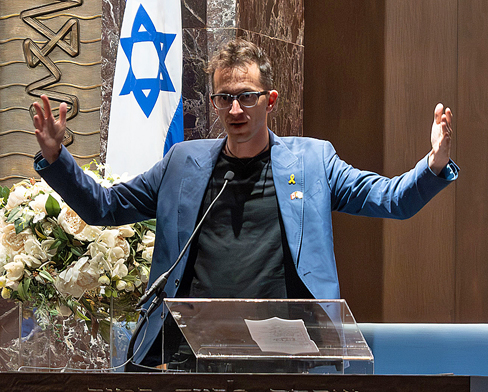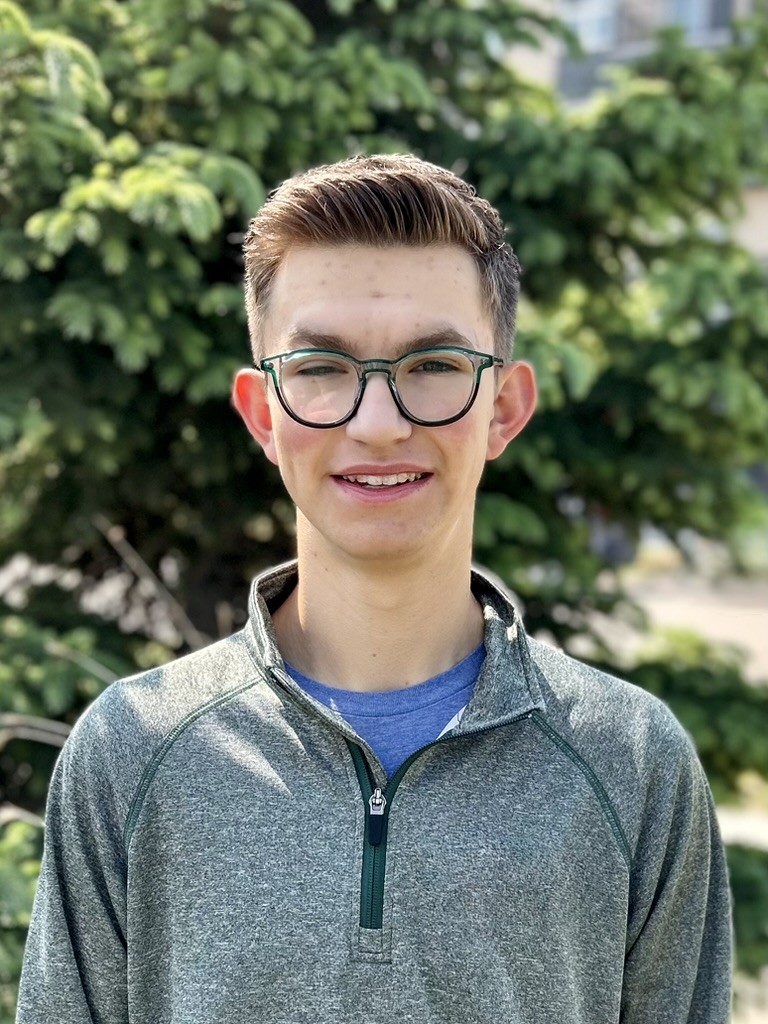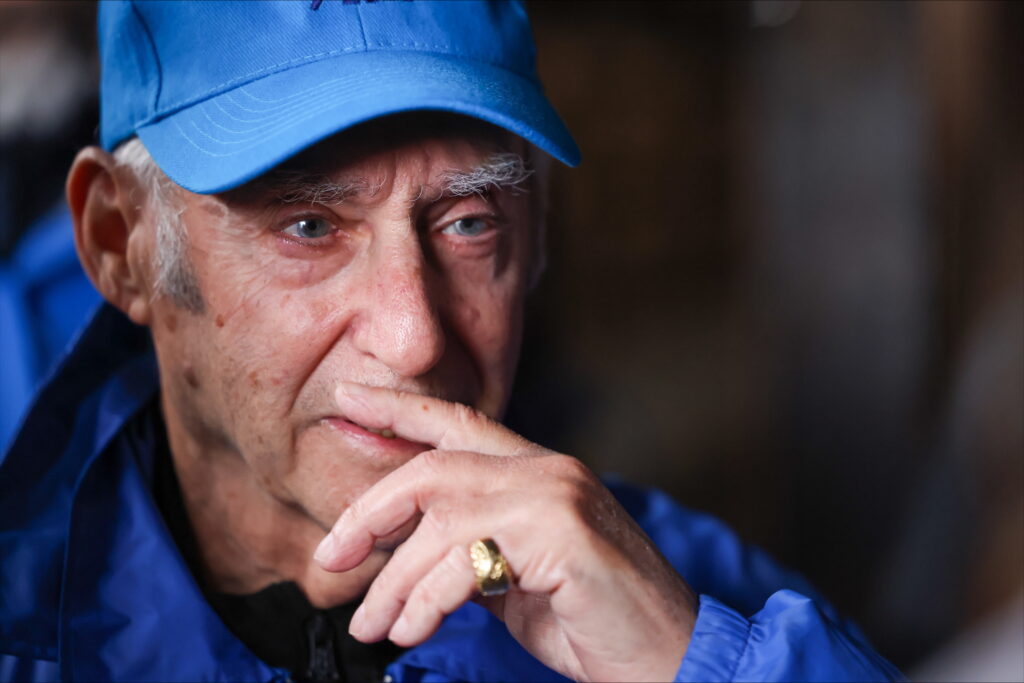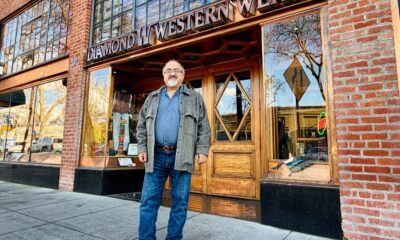Local News
Professor who fought back against rampant antisemitism at Columbia University speaks to large audience at Shaarey Zedek Synagogue

By BERNIE BELLAN Shai Davidai has established a reputation as a university professor who isn’t afraid to challenge what he perceives as unmitigated antisemitism – whether it’s coming from students, fellow professors or university administrators. A Management professor at Columbia University in New York City, Davidai, now 41, was in Winnipeg recently to speak to a crowd of around 300 at the Shaarey Zedek Synagogue on October 22.
Last year, Davidai gained renown for a video that was posted to Youtube on October 19 in which he railed against the administrators of major US universities, including Columbia, Harvard, and Stanford, for allowing anti-Israel protests to be held unchecked.
It was still in the early stages of what would eventually become a trend sweeping campuses across both the US and Canada, during which students (often joined by non-students) held rallies denouncing Israeli “genocide” in Gaza, almost always employing the usual epithets in describing Israel as “settler-colonialist,” guilty of “apartheid” and “ethnic cleansing.” Those rallies would soon transform into encampments, striking fear into the hearts of many Jewish students.
During his speech to Jewish students gathered in the Columbia University courtyard on October 19, 2023, Davidai denounced the hypocrisy of university administrators, saying: “they won’t allow a pro-ISIS rally or a pro-KKK rally, yet, when it comes to Israeli and Jewish lives, they allow a pro-terrorist Hamas=ISIS rally… US prestige universities allow pro-terror rallies on their campuses; will not call Hamas a terror organization…American parents, your kids are no longer safe on ANY university campus. Jewish students on any US campus are not safe because the undercurrent on US campus is anti-Semitic and the presidents of US campuses give a hand to bigotry-Antisemitism and allow terrorist Hamas supporters to rally for violence and terror.”
From that point on, Davidai became a symbol of hope for Jews as a professor who refused to remain silent in the face of university administrators who remained passive while antisemitism was being allowed to run rampant on university campuses – or who even abetted antisemitic behaviour in some cases.
Most recently, although he has not been fired (and Davdai noted that he does not have tenure), Columbia University is refusing to allow him to appear on campus in person.
Davidai’s talk in Winnipeg was facilitated by several organizations, most prominently one called “Tafsik,” about which you can read here: Tafsik
The evening got off to a rocky start, however, when the person who served as moderator – but who never introduced herself to the crowd, asked her son to come up to the podium and recite the standard acknowledgment that the Shaarey Zedek is situated on the “ancestral lands of” various indigenous groups. Unfortunately, her son said, he didn’t know the words – and neither did his mother. Fortunately, Shaarey Zedek Executive Director Rena Secter-Elbaze stepped up to the podium and read the acknowledgment herself.
After Amir Epstein, the founder of Tafsik, gave some remarks in which he explained how he came to start that organization, he introduced Shai Davidai. Epstein said he had no problem if anyone wanted to record Davidai’s remarks, but the person who was apparently the moderator immediately contradicted Epstein, insisting that no recordings would be allowed.
(In fact, aware of the prohibition on recording the event that had been included in emails sent out to attendees beforehand, I had contacted Epstein in advance, asking him whether I could be granted an exception to the rule. He responded that he had no problem with me recording Davidai’s remarks and, based on that, I did record Davidai’s entire speech. What you are about to read is taken verbatim from a transcript of Davidai’s remarks.)
Early on in his remarks Davidai explained that, until recently, he had never heard of Winnipeg but, when his son was born, he and his wife became involved in a “mom and daddy group,” among whose members was a former Winnipegger by the name of Marley Book.
Davidai said he asked Marley where she was from, and she answered “Canada.”
“I said, oh, are you from Toronto? No? Are you from Montreal? She said ‘no.’ I said, oh, are you from Vancouver? So now I’m like, running out of cities. And then she said, I’m from Winnie Peg.
“And I’ve never heard of Winnie Peg. And I said, ‘I’ve never heard of Winnie Peg.’ And – she said, ‘I’m Jewish.’ And I was like, we are literally everywhere…and throughout the years, she’s described to me what it’s like being Jewish in Winnie Peg and, and in a small community. But I never really got it until I showed up here.There’s something unique about a community where it feels like everybody knows everybody.”
Davidai went on to describe the exact moment when he and his wife were first informed about what was happening in Israel on October 7. He said that the last video he had on his phone before his wife received a WhatsApp message from her sister in Israel shortly after the attack began was a video in which he was saying to his wife that “our lives are boring.”
“I wish I can go back to having a boring life,” Davidai told the audience. “I wish we could all go back to having a boring life. But one thing I don’t wish for is going back to the way things were for many, many, many months…And now I say, never, we’re never going back to the way things were, because the way things were were not good.”
“The only difference between what’s happening now in universities and city streets and in Parliament and in the media and everywhere, is that the hatred (that) was underground, is now above the surface.”
Davidai explained to the audience how he went from being a passive observer of events to an activist who has now become a lighting rod, both for critics and defenders of Israel. It was while watching an angry group of kaffiayh-wearing students at Columbia University on October 12, 2023 who were gathered opposite a group of 50 Jewish students who were holding a silent vigil for the hostages who had been taken to Gaza, he said, that a fellow Israeli academic, “leaned over and whispers in my ear and says, this is the anti semitism that our parents and grandparents warned us about, the moment he said that something changed inside my mind. And once it changed, I can never go back to seeing things the way they were.”
“Now, I had an explanation of what I was seeing. This was Jew hatred.”
Soon after, Davidai said, he posted what he was feeling to Instagram – where, until that point, he had only 900 followers. That soon changed, however, as he explained: “The next day, I wake up and I notice that all of a sudden I have more than 900 followers, and none of them are academics. And people are sharing what I wrote, and people are texting me, thank you for writing. And people are saying, if you want to know what it feels like to be a Jew in North America right now, read this.”
As the days passed, and as Davidai became increasingly prominent on social media – for his Instagram posts and Youtube video of October 19 (to which he later added more videos), as much as Davidai was being lauded for how brave he was to confront the kind of antisemitism that was becoming thoroughly pervasive on so many university campuses, he admits now that he was “afraid” then and he’s still afraid, saying: “You may not see it. It may not seem like I’m afraid. I am very afraid. When I confront protesters – waving Hamas flags…I saw today in the Canadian news, with a Taliban flag being waved…My knees tremble, but I’m not a Jew who will let his trembling knees control him. And I think that that is where we all need to be. We are refusing to simply hide and let them slaughter us.”
So, how do we fight back, Davidai asked? He gave three suggestions:
“We all have to understand, including myself, none of us are doing enough.”
Secondly – “no one is coming to save us.”
As for his third suggestion, Davidai said it was more complicated because we have “outsourced our ability to protect ourselves” to Jewish “organizations.”
And, while he had nothing bad to say about Jewish organizations, especially their ability to raise massive amounts of money at a time of immediate peril to Israel, he noted that “Jewish organizations are built to fundraise They are built to lobby. They are built to teach and educate, and are built to deal with the media. And they have been doing that work amazing in the past year, in a few weeks,” yet what they are not built to do, Davidai suggested, is to “mobilize people.”
It’s up to us, Davidai insisted, “to get out in the streets. It’s our job to save ourselves.”
If you are “waiting for someone else,” he said, “do you really believe that someone else exists?”
“It’s not enough to write a letter or an email. It’s not enough to cite a petition. Those are good things, but they are not moving the needle. What we need to do is show up. Show up publicly….You need to be focusing on one thing today. Did I throw a pebble into the water or not? And that’s it.”
There was much more to Davidai’s talk, including not being afraid to be “publicly Jewish” by wearing, for instance, a Star of David, a kippah, or a dog tag since, as he insisted, “because when they come for us and tell us to hide, the best response is never hiding, because hiding has never worked for us in our history.”
“But the other thing we want to do is being there,” he added. “And it’s scary. Protesting. Protesting does not come natural to most people.”
Davidai suggested though, something he called the “rule of minyan” (ten). As he explained, “When there’s one person shouting, that person gets targeted. When there are ten people shouting, those people get heard.”
At the end of his remarks Davidai posed a series of questions to the audience: “We have people that are walking around and openly supporting terrorist organizations. And the decision that’s facing each and every one of us is a simple decision: Do you stand with the people that believe in democracy, or do you stand with the people that believe in terrorism?
“Do you stand with the victim, or do you stand with the rapist?
“Do you stand with Western values, or do you stand with those that want to burn it all down?
“That’s not a complicated decision. How we solve this problem is complex.
“There is no one silver bullet. But where you stand on this issue is very, very simple.
“That is the message that I want to send, not to all of you here because you get it.
“But that’s the message that I want to send to every non Jewish comedian, every non Jewish American and every non Jewish person around the world, show up one time to our rallies, show up one time to their protests.
“And you tell me, where, which world do you want your kids to grow up in?”
Local News
Further to the Simkin Centre’s financial situation

By BERNIE BELLAN A while back I published an article about the deficit situation at the Simkin Centre. (You can read it at “Simkin Centre deficit situation.“) I was prompted to write that particular article after reading a piece written by Free Press Faith writer John Longhurst in the August 5 issue of the Free Press about the dire situation personal care homes in Winnipeg are in when it comes to trying to provide their residents with decent food.
Yet, Longhurst made one very serious mistake in his article when he wrote that the “provincial government, through the Winnipeg Regional Health Authority, has not increased the amount of funding it provides for care-home residents in Manitoba since 2009.”
In fact, the WRHA has given annual increases to personal care homes, but its allocations are not broken down by categories, such as food or salaries. As a spokesperson for the WRHA explained to me in an email: “PCHs receive per diem global operating funding based on the number of licensed beds they operate. This funding model is designed to support the full range of operating costs associated with resident care, including staffing, food services, utilities, building operations, and other day-to-day expenses.”
Now, one can make a perfectly valid argument that the level of funding from the WRHA has not kept up with inflation, especially inflation in food costs, but the Simkin Centre is in an even more precarious position because of the skyrocketing cost of kosher food.
“In recent years,” according to an article on the internet, “the cost of kosher food has increased significantly, often outpacing general food inflation due to unique supply chain pressures and specialized production requirements.”
Yet, when I asked Laurie Cerqueti how much maintaining a kosher facility has cost the Simkin Centre, as I noted in my previous article about the deficit situation at Simkin, she responded: “approximately $300,000 of our deficit was due to food services. I do not have a specific number as far as how much of the deficit is a result of kosher food…So really this is not a kosher food issue as much is it is an inflation and funding issue.”
One reader, however, after having read my article about the deficit situation at Simkin, had this to say: “In John Longhurst’s article on Aug 5, 2025 in the Free Press, Laurie (Cerqueti) was quoted as saying that the annual kosher meal costs at Simkin were $6070 per resident. At Bethania nursing home in 2023, the non-kosher meal costs in 2023 were quoted as $4056 per resident per year. Even allowing for a 15% increase for inflation over 2 years, the non-kosher food costs there would be $4664.40 or 24% lower than Simkin’s annual current kosher food costs. If Simkin served non-kosher food to 150 of its 200 residents and kosher food to half of its Jewish residents who wish to keep kosher, by my calculation it would save approximately $200,000/year. If all of Simkin’s Jewish residents wished to keep kosher, the annual savings would be slightly less at $141,000.”
But – let’s be honest: Even though many Jewish nursing homes in the US have adopted exactly that model of food service – where kosher food is available to those residents who would want it, otherwise the food served would be nonkosher, it appears that keeping Simkin kosher – even though 45% of its residents aren’t even Jewish – is a “sacred cow” (pun intended.)
So, if Simkin must remain kosher – even though maintaining it as a kosher facility is only adding to its accumulated deficit situation – which currently stands at $779,426 as of March 31, 2025,I wondered whether there were some other ways Simkin could address its deficit while still remaining kosher.
In response to my asking her how Simkin proposes to deal with its deficit situation, Laurie Cerqueti wrote: “There are other homes in worse financial position than us. There are 2 homes I am aware of that are in the process of handing over the keys to the WRHA as they are no longer financially sustainable.”
I wondered though, whether the Simkin Centre Foundation, which is managed by the Jewish Foundation of Manitoba might not be able to help the Simkin Centre reduce its deficit. According to the Jewish Foundation’s 2024 annual report, The Saul and Claribel Simkin Centre Foundation, which is managed by the Jewish Foundation, had a total value of $11,017,635.
The Jewish Foundation did distribute $565,078 to the Simkin Centre in 2024, but even so, I wondered whether it might be able to distribute more.
According to John Diamond, CEO of the Jewish Foundation, however, the bylaws of the Foundation dictate that no more than 5% of the value of a particular fund be distributed in any one year. There is one distinguishing characteristic about the Saul and Claribel Simkin Centre Foundation, in that a portion of their fund is “encroachable.” The encroachable capital is not owned by JFM. It is held in trust by JFM but is beneficially owned by Simkin, similar to a “bank deposit”. While held by the JFM, these funds are included in the calculation of Simkin’s annual distribution.
I asked John Diamond whether any consideration had been given to increasing the distribution that the Jewish Foundation could make to the Simkin Centre above the 5% limit that would normally apply to a particular fund under the Foundation’s management.
Here is what John wrote in response: “The Simkin does have an encroachable fund. That means that at their request, they can encroach on the capital of that fund only (with restrictions). This encroachment is not an increased distribution; rather, it represents a return of capital that also negatively affects the endowment’s future distributions.
”It is strongly recommended that encroachable funds not be used for operating expenses. If you encroach and spend the capital, the organization will receive fewer distribution dollars in the next year and every year as the capital base erodes. Therefore, the intent of encroachable funds is for capital projects, not recurring expenses.”
I asked Laurie Cerqueti whether there might be some consideration given to asking for an “encroachment” into the capital within the Saul and Claribel Simkin Centre Foundation?
She responded: “We are not in a position where we are needing to dip into the encroachable part of our endowment fund. Both of our Boards (the Simkin Centre board and the Saul and Claribel Simkin Centre Foundation board) are aware of our financial situation and we are all working together to move forward in a sustainable way.”
At the same time though, I wondered where donations to the Simkin Centre end up? Do they all end up in the Simkin Centre Foundation, for instance, I asked Laurie Cerqueti on December 15.
Her response back then was: “All donations go through our Foundation.”
I was somewhat surprised to read that answer, so I asked a follow-up question for clarification: “Do all donations made to the Simkin Centre end up in the Simkin Centre Foundation at the Jewish Foundation?”
The response this time was: “No they do not.”
So, I asked: “So, how do you decide which donations end up at the Foundation? Is there a formula?”
Laurie’s response was: “We have a mechanism in place for this and it is an internal matter.”
Finally, I asked how then, the Simkin Centre was financing its accumulated deficit? Was it through a “line of credit with a bank?” I wondered.
To date, I have yet to receive a response to that question. I admit that I am puzzled that a personal care home which has a sizeable foundation supporting it would not want to dip into the capital of that foundation when it is facing a financial predicament. Yes, I can see wanting the value of the foundation to grow – but that’s for the future. I don’t know whether I’d call a $779,425 deficit a crisis; that’s for others to determine, but it seems pretty serious to me.
One area that I didn’t even touch upon in this article, though – and it’s something I’ve written about time and time again, is the quality of the food at the Simkin Centre.
To end this, I’ll refer to a quote Laurie Cerqueti gave to John Longhurst when he wrote his article about the problems personal care homes in Winnipeg are facing: “When it comes to her food budget, ‘we can’t keep making the same number of bricks with less straw.’ “
Local News
Exclusive: Security Enhancement Fund to be announced by Province in coming days

By NOAH STRAUSS The province is set to announce a new program called the Security Enhancement Fund, which
will provide funding to religious and faith groups to improve security at institutions such as
synagogues and mosques. In an exclusive interview, Minister of Justice Matt Wiebe outlined the
plan and detailed what the province has already done to help protect Jewish Manitobans.
“What we want to do is to be able to provide the community with the kind of tools that they need
to stay safe and to ensure that everyone in the community feels safe,” said Wiebe.
The fund will provide a missing link between government and religious communities, and
communities will now be able to make their own choices without money being a big restraint.
Essentially, the power will be in the hands of community leaders and not government officials.
The minister noted that the new partnerships will provide the province a better understanding of
the needs of every community. Rather than the province making the choices, they are
essentially giving a voice to each community. The grants, totalling $1 million, will provide funds to enhance security at facilities like synagogues.
The Jewish Post reached out to Dr. Rena Secter Elbaze, executive director of Congregation
Shaarey Zedek. “It’s important that the government show us that they’re taking security seriously and stepping up to the plate to make this offer. We will absolutely be applying for grant money,” she said. Elbaze also wants to know whether or not the government will cover the costs of things the synagogue has already spent money on. She noted that the province has, in the past, made grants available to have security guards present.
When speaking about what the Justice Ministry has already done to protect Jewish Manitobans,
Wiebe brought up the new special prosecutor that is focusing on hate crimes. Wiebe said the
special prosecutor works closely with the Winnipeg Police Service “to support investigations and
prosecute hate crimes. Wiebe also went on to say how the Department of Education has been helping to fight antisemitism. “The creation of the Holocaust education curriculum is an important step in the right direction,” he said. When asked about Oliver Didtger Ederhof, the individual charged with 14 counts of mischief including vandalism of Shaarey Zedek, Wiebe said decisions like bail and police undertakings are decisions that are in part made by the federal government through the criminal code and policies. “We’re going to continue to advocate for stricter bail reform at the federal level…. I’ve been very clear, we issued clarified directives around bail to our Crown prosecutors.”
The full announcement from the province is expected in the coming days.
Local News
March of the Living 2023 participants form Taste of Hope project to help honour the memory of Holocaust survivor Alex Buckman

By BERNIE BELLAN The March of the Living is an annual two-week international educational program that brings thousands of students and adults to Poland and Israel to study the Holocaust, Jewish history, and the rise of the State of Israel. Founded in 1988, it features a 3-kilometer silent walk from Auschwitz to Birkenau on Yom HaShoah (Holocaust Remembrance Day).
Attendees on the march are accompanied by adults, some of whom themselves have been Holocaust survivors.
Following the week in Poland, participants travel to Israel to observe Yom HaZikaron (Israel’s Memorial Day) and celebrate Yom HaAtzmaut (Israel’s Independence Day), marking a journey from darkness to life.
For many years the coordinator of the march in Winnipeg was Roberta Malam, working on behalf of the Jewish Federation of Winnipeg. More recently Abby Flackman filled that role, and now the person in charge is Lindsey Kerr.
Since its inception 37 years ago the March of the Living has become a rite of passage for many young Winnipeg Jews who have been able to participate as an organized group from Winnipeg and combine visits to the death camp at Auschwitz-Birkenau in Poland with the subsequent trip to Israel.
Then – the Covid pandemic hit – in 2020, and the March of the Living was put on hold for two years – in 2020 and 2021.
In 2022, the March of the Living resumed, but there was no organized contingent from Winnipeg participating. (There may have been some Winnipeggers who did go on the march that year, but if there were any they would have been part of a general Canadian group since there was no Winnipeg coordinator that year.)
In 2023, however, once again a very large contingent of young Canadian Jews – 51 altogether, of whom approximately two-thirds were from Winnipeg, went on that year’s March of the Living. That particular march was memorable for many reasons, including the fact it was the last full march since 2019 and was to remain the last march to have an organized Winnipeg contingent in the past six years as the years 2024 and 2025 were interrupted by the war in Gaza. (There were smaller marches held in 2024 and 2025, but again there was no organized contingent from Winnipeg.)
Recently, we were contacted by one of the participants of that 2023 march, Ethan Levene, who asked us whether we’d be interested in running what turned out be a very poignant story about one particular aspect of that 2023 March of the Living.
Here is what Ethan wrote:
“In April 2023, the Coast to Coast Canadian delegation of March of the Living was privileged to travel with Holocaust survivor Alex Buckman (z”l). March of the Living is a Holocaust education trip that allows participants to visit and bear witness to the sites of the Holocaust. Unfortunately, while sharing his story in Poland, Alex passed away. However, the impact he left on us students was immeasurable.

“While speaking to us in Warsaw, Alex told us the story of his Aunt Becky’s gâteau à l’orange (orange cake). While in Ravensbruck concentration camp, his aunt managed to write down this recipe. After his parents’ murder, his Aunt Becky went on to raise Alex after surviving. In addition to sharing his story, Alex tasked us with baking the cake with family and friends.
“Out of this, a group of alumni from our trip have created this project: ‘A Taste of Hope.’ On February 1st, university students from over 5 universities across Canada will come together to bake the gâteau à l’orange and hear Alex’s story. Proceeds from the event and this fundraising page will support the World Federation of Jewish Holocaust Survivors and Descendants. Alex was heavily involved with this organization, whose mission is to both create community for Holocaust survivors and their descendants and educate about the Holocaust to help fight against antisemitism and all forms of bigotry and hate.
“Here is information from our fundraising page for the event – ‘A Taste of Hope’: Fundraising for A Taste of Hope.
Ethan added that “it’s completely student led, all by alumni from our 2023 trip attending university at these various locations across Canada; Winnipeg, London, Kingston, Montreal.”
He also added: “Follow us on instagram@tastehope.“
Here is a link to a CBC story about Alex Buckman: Alex Buckman story
In a subsequent email Ethan gave the names of Winnipeggers who are involved in A Taste of Hope: Ethan Levene (studies at McGill), Zahra Slutchuk, Alex Stoller (studies at Queens), Coby Samphir, Izzy Silver (studies at Waterloo).
He also added names of others who are involved in the project: Jessie Ages, Anneke Goodwin, Lilah Silver, Ella Pertman, Ellie Vogel, and Talia Cherun.
To find out more about March of the Living in Winnipeg go to: March of the Living




